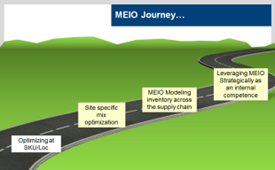
 As I talk to customers and practitioners from all corners of the supply chain world, I find that Inventory Optimization has different meanings between companies, departments and even people within the same organization. It is described as everything from simple inventory management techniques all the way to advanced multi-echelon optimization.
As I talk to customers and practitioners from all corners of the supply chain world, I find that Inventory Optimization has different meanings between companies, departments and even people within the same organization. It is described as everything from simple inventory management techniques all the way to advanced multi-echelon optimization.
Recently I presented at a local APICS event on the Inventory Optimization Maturity Curve. In the presentation I took the audience on a quick guided tour through the different levels of inventory optimization and what we mean by each, from the tactical deployment of safety stocks for SKUs to the strategic use of inventory analytics in driving the sales and operations planning (S&OP) process.
To provide a useful context around this, we can determine where we are on the maturity scale and initiate the process to move up.
At its simplest level, many organizations start by applying science to inventory with a single item, single location safety stock calculation to define how much inventory is needed to cover demand, lead times and ordering frequency for a given level of service. Most companies start this inventory journey either through spreadsheets or by using the simple safety stock modeling capabilities of an ERP system.
In my experience today many companies are at this “rules of thumb phase”. If this describes your situation, don’t feel bad, you should be excited because you have a big opportunity. Don’t be scared by the prospect of optimization — because there are some simple things you can do to gather that low hanging fruit.
The next level of maturity is to set a statistical safety stock systematically for all item locations as part of the tactical planning process, and to introduce some more advanced considerations like supply and demand uncertainty and time-phasing of the safety stock. Here we model the supply chain from raw materials through work in process and out into the distribution channels to the customer. Uncertainty can be propagated up and down the chain, understanding the interdependencies of each node in the supply chain.
This approach requires complex non-linear math that provides a degree of inventory optimization you cannot get from single tier solutions. It provides great strategic information that allows you to understand analytically the causes of inventory, target strategic improvement initiatives that maximize performance, and truly approach best in class in inventory optimization.
The next level in the maturity curve is MEIO — multi-echelon inventory optimization. Single node or tier inventory optimization is great — but it doesn’t help with the greater challenge — optimizing inventory across a supply chain network. Having multiple tiers in your supply chain typically causes more inventory to be held. There is typically double buffering for the same uncertainty and no real idea of how inventory decisions in one tier impact the cost and service of the overall supply chain. This is where the concept of multi-echelon inventory optimization comes into play.
Remember, optimization is not just about reducing inventory, it is about getting the correct inventory to support your service goals — the optimal mix of inventory.


